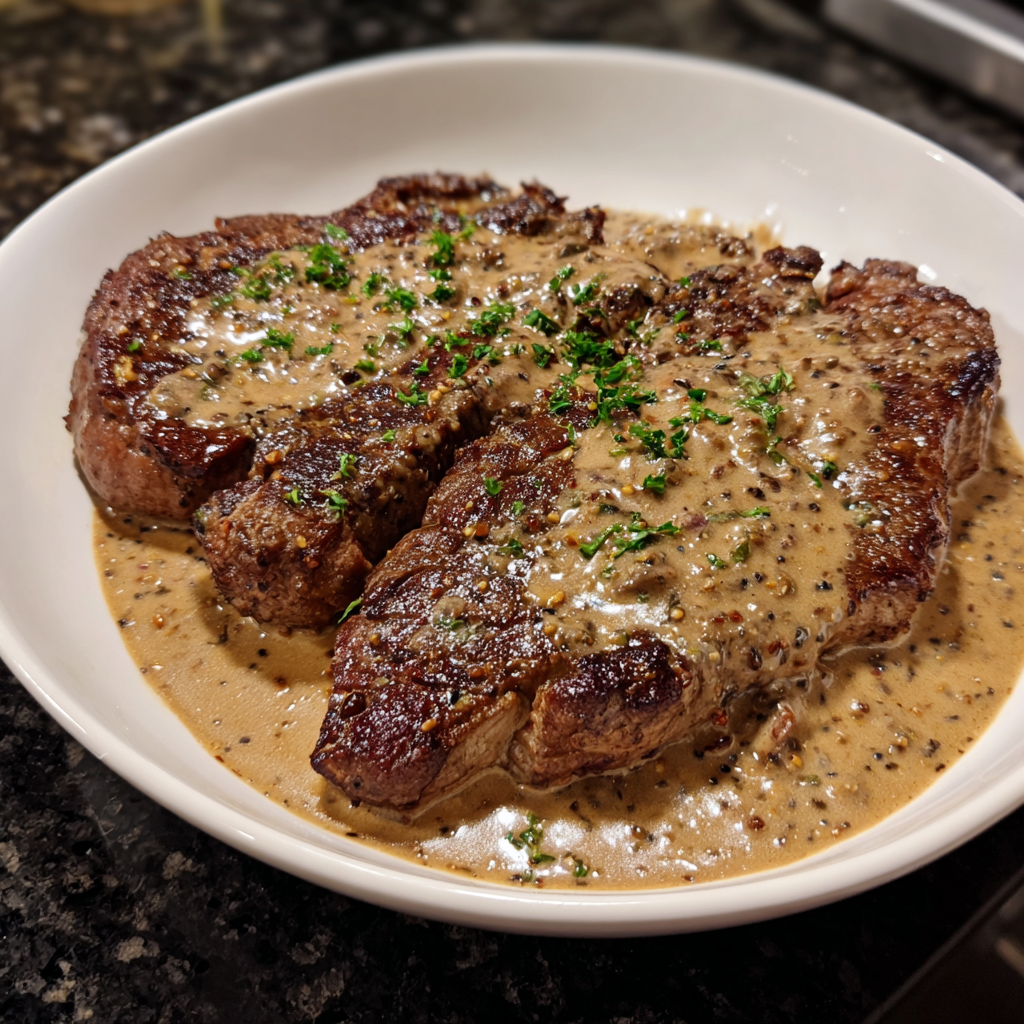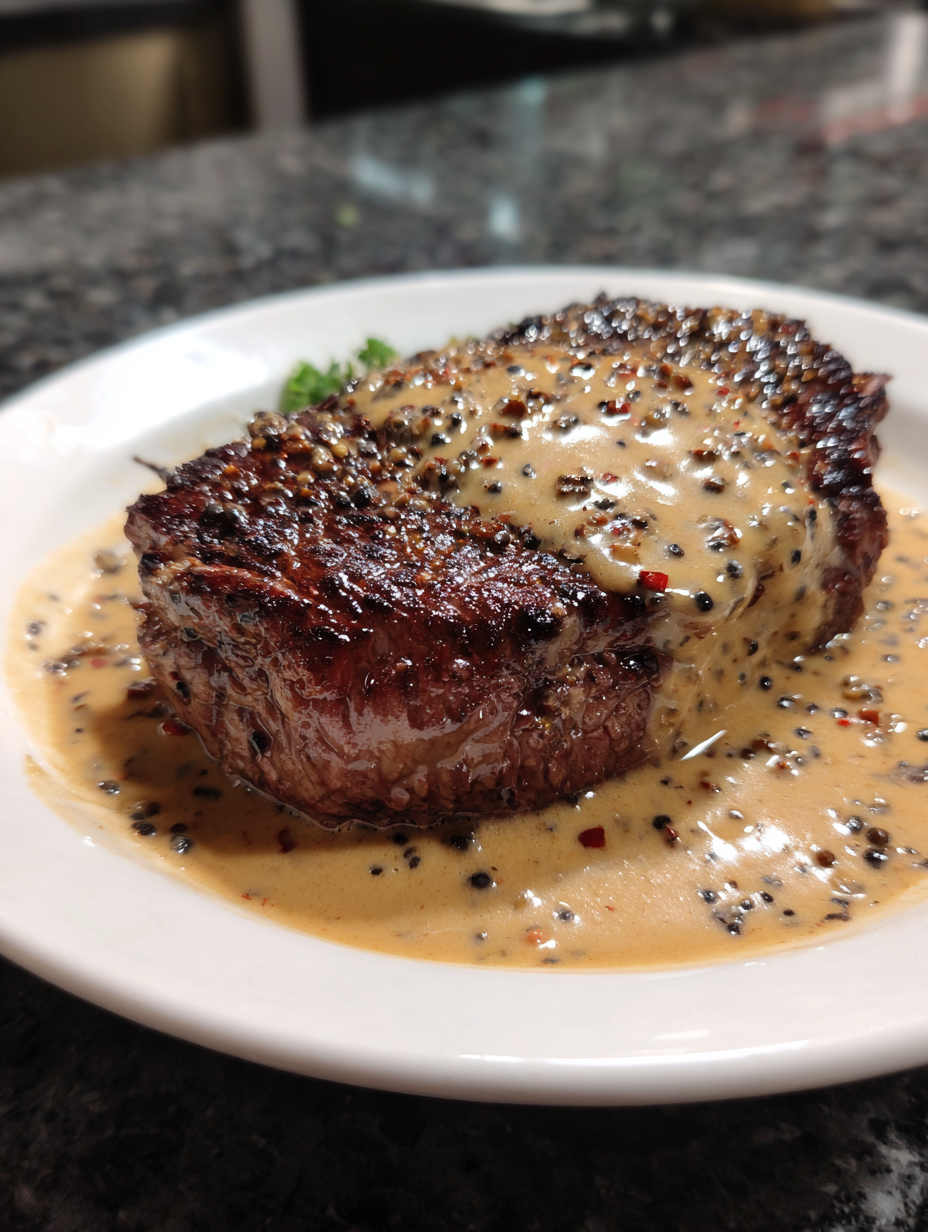 Pin it
Pin it
Nothing makes steak night feel special like a homemade creamy peppercorn sauce. This silky sauce delivers just the right balance of spicy warmth from cracked peppercorns mellowed by a splash of cream. Whether you drizzle it on steak chicken or roasted vegetables it brings a restaurant-worthy finish to meals in less than twenty minutes.
I still remember the first time I made this for my partner during a Friday date night at home. Since then it is our go-to sauce for lazy steak dinners or anytime we want to make an everyday meal feel a little bit fancier.
Ingredients
- Unsalted butter or oil: gives a rich luscious base and helps soften the aromatics
- Shallots: bring gentle sweetness and a depth of flavor shallots should look shiny purple and feel firm
- Fresh garlic: boosts the savoriness and creates a wonderful aroma pick plump garlic with tight skin
- Coarsely crushed black or mixed peppercorns: are the star ingredient delivering bold spicy notes grind them fresh if possible for maximum aroma
- Brandy cognac or dry wine: round out the flavor and deglaze the brown bits from the pan choose a wine you would enjoy drinking
- Chicken or beef stock: adds savory depth use a low-sodium variety for more control over saltiness
- Heavy cream: creates the signature creamy texture and rounds out the spice whole milk or coconut cream are good substitutes
- Dijon mustard: for a subtle tang and boost of complexity look for smooth and pale yellow Dijon
- Salt: balances everything so add to taste
- Worcestershire sauce: introduces a little umami and depth just a few drops will do
- Fresh thyme or rosemary as garnish: for a fragrant finish pick vibrant fresh sprigs for best flavor and appearance
Step-by-Step Instructions
- Sauté the Aromatics:
- Melt the butter or heat the oil in a medium skillet over medium heat. Add the chopped shallots and minced garlic letting them soften and become fragrant. Stir often until they look translucent but not browned. This step takes about three minutes and builds the savory backbone of the sauce.
- Crush the Peppercorns:
- While the aromatics cook use a mortar and pestle to crush the peppercorns coarsely. Leave a few bigger bits for bursts of flavor and a satisfying texture in the final sauce.
- Deglaze the Pan:
- Pour brandy wine or a splash of stock into the hot pan. Use a wooden spoon to scrape any browned bits from the bottom of the skillet as these bring loads of flavor into the sauce. Let the liquid simmer for about two minutes so any alcohol burns off.
- Add Liquids and Simmer:
- Stir in the remaining stock and pour in the cream. Raise the heat until everything starts to bubble then lower it back to a gentle simmer. Let it cook for about five minutes stirring often so it thickens and starts coating the back of your spoon.
- Finish the Sauce:
- Whisk in Dijon mustard if using and splash in a bit of Worcestershire sauce. Taste and add a pinch of salt if needed. For a perfectly smooth finish strain the sauce through a fine mesh sieve pressing with a spoon to catch all the flavor.
- Adjust and Serve:
- If you like a thicker sauce simmer a minute or two longer. If you want it thinner add a splash more stock or cream. Serve the sauce piping hot over steak roasted meat or vegetables and scatter with fresh herbs if desired.
 Pin it
Pin it
I love using freshly crushed peppercorns in this sauce. The aroma reminds me of Sunday lunches with my dad who always requested extra sauce for his potatoes. Serve this on a special occasion or just because it is too good to save for only steak.
Storage Tips
This sauce keeps well in an airtight container in the fridge for up to three days. When reheating warm it gently over low heat stirring often so the cream does not separate. It is best to avoid high heat to preserve the silky texture. If the sauce has thickened too much in the fridge a splash of cream or milk will bring it back to pouring consistency.
Ingredient Substitutions
For a dairy-free version coconut cream works well though it adds a subtle sweetness. Swap shallots for a quarter of a small onion if you are out. If you prefer less heat use green peppercorns or reduce the amount of black pepper. Vegetable stock can take the place of chicken or beef stock for a lighter taste.
Serving Suggestions
Spoon this over classic grilled steak or roast beef for a timeless pairing. It is gorgeous on roasted cauliflower or asparagus and even brings chicken breasts to life. Sometimes I save a little sauce for warm crusty bread which is honestly one of my favorite steakhouse indulgences at home.
Cultural Context
Peppercorn sauce has French roots often called sauce au poivre in classic bistros. Traditionally served with steak it is known for the exciting marriage of creamy butteriness and piquant black pepper. While modern versions add variations like Cognac or Dijon the spirit of the sauce remains an adaptable luxury for cooks of all backgrounds.
Frequently Asked Questions
- → What type of peppercorns work best in the sauce?
Coarsely crushed black peppercorns are classic, but a mixed peppercorn blend adds complexity. Adjust the amount to your spice preference, starting with 1 teaspoon and adding more to taste.
- → Can I make this sauce dairy-free?
Absolutely! Substitute coconut cream or another plant-based cream alternative for the heavy cream. The flavor will be slightly different, but still delicious.
- → What's the best way to store leftover sauce?
Store leftover sauce in an airtight container in the refrigerator for up to 3 days. Reheat gently over low heat, adding a splash of stock or cream if needed to thin it out.
- → What wine pairs well with this peppercorn sauce?
A dry red wine like Cabernet Sauvignon or Merlot pairs exceptionally well with this sauce, especially when served with steak. The wine's tannins complement the richness of the sauce and the beef.
- → How can I adjust the thickness of the sauce?
To thicken the sauce, continue simmering it over low heat until it reaches your desired consistency. To thin it, add a splash of stock or cream.
- → Can I make this sauce ahead of time?
Yes, this sauce can be made ahead of time. Store it in the refrigerator and reheat it gently over low heat just before serving. Add a splash of liquid if it becomes too thick during reheating.
